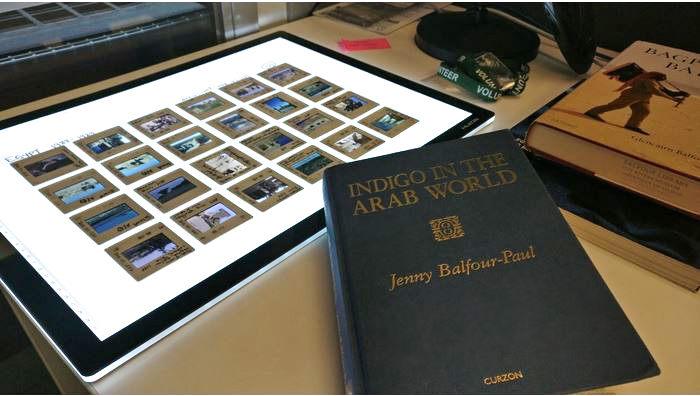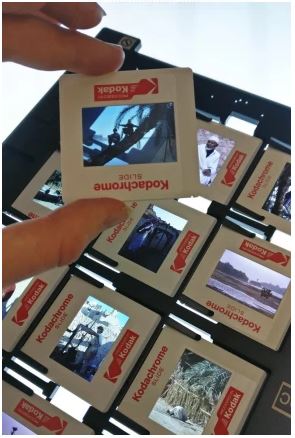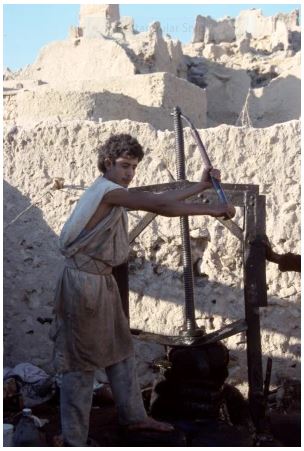Student Placement: Working in the Pitt Rivers Museum Photograph and Manuscript Collection
Student Placement: Working in the Pitt Rivers Museum Photograph and Manuscript Collection
By Cara Turner, Second Year BA History of Art, July 2020
Having spent time at the Pitt Rivers Museum whilst researching a Nigerian mask for the extended ‘Object Essay’ in first year, I was keen to see beyond the surface of the museum. The collections placement, a co-ordination between the Department of History of Art and a variety of Oxford’s incredible collections, allowed me to do this as part of the second-year course.
During the Michaelmas and Hilary terms, I spent one morning a week in the Photograph and Manuscript Collections at the Pitt Rivers Museum. The museum has a vast and varied collection of photographs, with a focus on ethnographic fieldwork. The Photograph and Manuscript Collections team make these accessible to the public and academics, through digitisation, facilitating visits to the collections, and exhibitions. For example, in 2017 the exhibition Embroidered Visions showcased the photographs of textile expert Sheila Paine from central Asia and the Middle East.

©Pitt Rivers Museum, University of Oxford
My placement focused on digitising the fieldwork collection of Jenny Balfour-Paul, an artist, traveller and academic who has worked extensively on indigo, an incredibly versatile natural blue dye. The collection documents her travels in North Africa and the Middle East, mainly from the 1980s. The collection had been donated as physical slides, and my task was to scan these in order to add them to the museum’s database, so that eventually the general public will be able to access them via the online collections.
Having grown up surrounded by digital photography, I enjoyed the materiality of the slides. Picking them up, squinting at the minuscule pieces of plastic. Seeing the images appear on the computer screen after scanning was a revelatory process that led me through Jenny’s travels. As well as scanning the slides, I worked on the database to prepare entries for the digitised photographs. It was useful to gain insight in to how the database – which I had used for my object essay – is set out with specific parameters which must be carefully adhered to in order to make research and browsing smooth. Although the project has been put on hold due to the corona virus crisis, I look forward to eventually seeing the collection available on the database to the general public.

©Pitt Rivers Museum, University of Oxford
Jenny’s photographs show the varied ways in which indigo is produced and used in different cultures. Her publications have charted the history of indigo as a substance used in multiple spheres of life, from producing medicines to textile dyeing. Many of us would associate indigo with dyeing our jeans, although natural indigo is now often replaced with synthetic dye. However, as Jenny’s fieldwork demonstrates, the production and use of natural indigo runs deep in many cultures. Her photographs feature the individuals, tools, methods and buildings involved in the process of dying with indigo, and the myriad of resulting effects and products. Some of my favourite photographs captured women dressed head to toe in indigo garments with their hands immersed in the dark blue dye.
Yet the collection also takes in the broader sights Jenny experienced on her journeys, from historic sites to bustling markets. One week I would be led through the classical sites at Palmyra, poignantly undisturbed; another, I would see the step pyramids at Saqqara and palm trees on the banks of the Nile.

Squeezing cloth during the indigo dyeing process. Egypt 1989 ©Pitt Rivers Museum, University of Oxford (2018.137.1239)
Overall, the placement was an opportunity both to experience the world through the eyes of a traveller and academic, and gain behind-the-scenes access to a world-class museum. Being in the office in the Photograph and Manuscript Collection gave me insight into the work of its staff, many of whom work on their own research alongside the daily tasks of co-ordinating exhibitions, visits and other projects. Using a Mac, the scanning software and the database were fairly new experiences for me – adapting to technology and other elements of a new work environment are positive experiences which the Collections Placement can offer. During coffee breaks, I met staff from across the museum, involved in conservation, education and more – as a student, it was interesting to hear about the varied paths that had brought people to the Pitt Rivers, and what their day-to-day roles involve. I would encourage future students to look forward to the Collections Placement as an element of variety in their week, something that will contextualise and add another dimension to their studies.
For more information about the BA History of Art course see the Department’s Programme Overview page.




